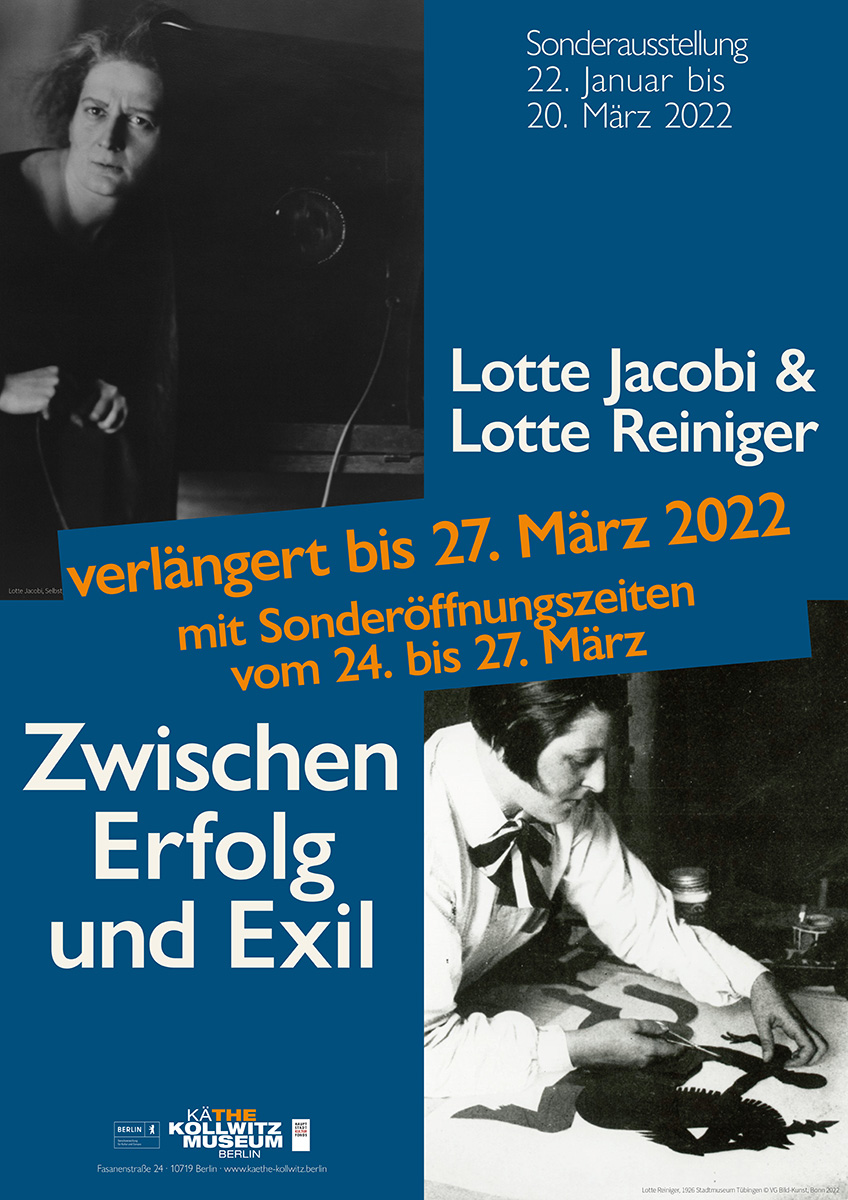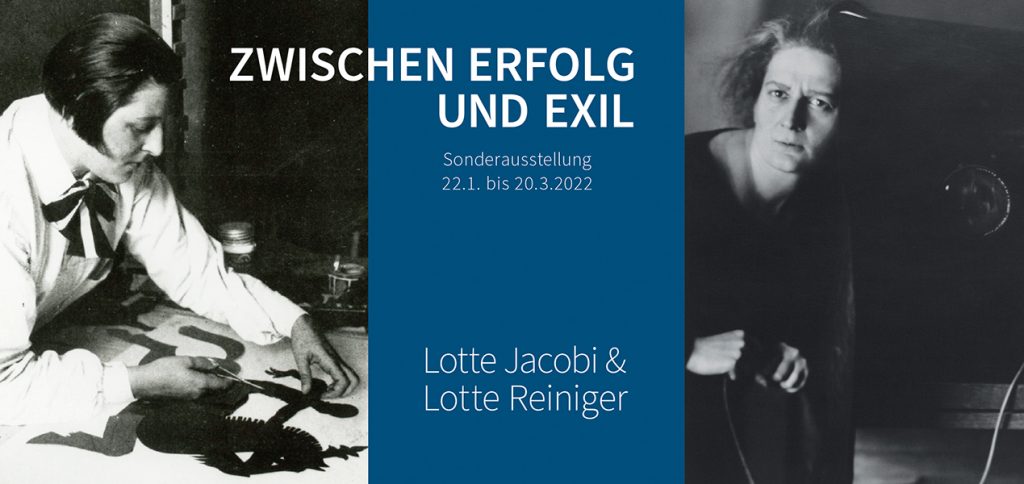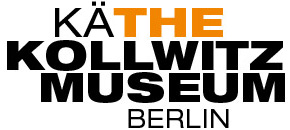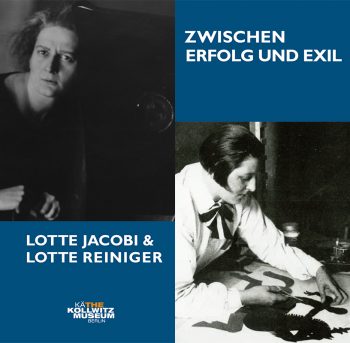
Special exhibition from January 22, till March 20, 2022, extended till March 27, 2022
Film afternoon at the Kollwitz Museum
“The Adventures of Prince Achmed”
Saturday, March 19, 2022
at 16:30
Film screening is included in the admission price.
Limited number of participants – advance registration is requested.
(e-mail to info@kaethe-kollwitz.de or by phone 030 882 52 10
or you can conveniently book a time slot ticket via our homepage).
Film length: 66 minutes
The screening is subject to 3G regulations plus FFP2 mask obligation.
Experience Lotte Reiniger’s classic film “The Adventures of Prince Achmed” from 1926, the first feature-length animated film in film history, in our museum cinema. The young animation pioneer created the silhouette film with a small team in three years of work. About 250,000 frames were exposed on the animation table, of which about 96,000 were finally used. The countless filigree silhouettes were brought to life in a stop-motion process.
Film composer Wolfgang Zeller, in close contact with Lotte Reiniger, wrote a symphonic score for the film, which was performed live at the time. The first screening took place on May 2, 1926 as a matinee screening (mainly for invited guests such as directors, producers and colleagues from the film and theater industry) at the Berlin Volksbühne on Bülowplatz (today: Rosa-Luxemburg-Platz). A glittering premiere of the film took place – through the mediation of the French film director Jean Renoir – in July 1926 at the Comédie des Champs-Elysées in Paris – and via this detour “Prinz Achmed” came to Berlin again, where it was shown on September 3, 1926 at the Gloria-Palast at the Gedächtniskirche.
To this day, Lotte Reiniger’s masterpiece, based on motifs from the Arabian Nights story collection, has lost none of its fascination.

As part of its last special exhibition at its current location, the Käthe Kollwitz Museum is dedicated to the work of two outstanding female artists of the Weimar Republic. Lotte Jacobi (1896-1990), whose world revolved around photography, and Lotte Reiniger (1899-1981), who devoted herself to silhouettes.
With curiosity, talent and business acumen, the photographer and the animation pioneer made their way in the male-dominated art scene and moved in the same circles as our house artist. The special exhibition shows how their careers began in the up-and-coming, vibrant cultural scene of 1920s Berlin and flourished until their emigration in 1935.
Lotte Jacobi came from a family of photographers steeped in tradition and, in addition to portrait photography, turned with preference to theater and dance photography. While shooting portraits for the cover of a newly founded women’s magazine, the young photographer met Käthe Kollwitz in 1929.
Jacobi’s father’s portrait studio in the heart of Berlin’s New West, which she took over in 1927 after completing her training in Munich, had a prestigious clientele. However, she always preferred working on location, in the theaters of the metropolis and also in the studios of artists, to studio work.
She created unique portraits such as that of Lotte Lenya at the premiere of the “Dreigroschenoper” in the summer of 1928, but her photographic repertoire also included unconventional double portraits such as that of the comedian duo Karl Valentin and Liesl Karlstadt. Her photographs were widely published in newspapers and magazines. With the onset of National Socialist rule, however, the successful photographer was forced to emigrate with her family to the USA in 1935.
Lotte Reiniger also decided to leave Germany with her husband Carl Koch in 1935. Yet the animated film artist was already firmly established in Berlin’s cultural life, shooting commercials for the advertising filmmaker Julius Pinschewer, making stage designs and befriending other contemporaries of the avant-garde. Reiniger’s acquaintance with actor and silent film director Paul Wegener and his referral to the Institute for Cultural Research, founded in 1919 by cultural filmmaker Hans Cürlis, marked the beginning of her long career. Here she created her first silhouette film and met her husband and most important collaborator. Her best-known animated film, and also her first feature-length animated film, was “The Adventures of Prince Achmed.” Thanks to the generous financing of the Jewish banker Louis Hagen, she and her team were able to realize this film in three years of work in Potsdam. In doing so, she was years ahead of Walt Disney. After the Reiniger-Koch couple dissolved the Berlin production facility in early November 1935, they traveled first to London, and later to Paris and Rome. Before moving to London in 1949, the filmmakers survived the (post-) war years in Berlin, where Reiniger worked for the Berlin Shadow Stage.
The two artists meet for the first time in an exhibition and promise to make an exciting exhibition pair whose work is language-free and understood interculturally. Photographer Lotte Jacobi will be presented with around 45 photographs of well-known personalities from the fields of visual and performing arts, literature and science. The world-renowned filmmaker Lotte Reiniger will be represented with around 30 silhouettes, drawings, sketchbooks, storyboards as well as her silhouette films.
On display are primarily works from the holdings of the Berlinische Galerie, the Deutsche Kinemathek, the Jewish Museum, the Akademie der Künste, and the Ullstein Bildarchiv. The exhibits on Lotte Reiniger, on the other hand, come mainly from the Stadtmuseum Tübingen, which is in charge of the filmmaker’s estate. Wasmuth Verlag is also making available the portfolio from 1926 that was created for the Achmed film as part of the special exhibition.
The realization of the exhibition and the accompanying publication is thanks to the financing of the Hauptstadtkulturfonds.
Catalogue
Lotte Jacobi & Lotte Reiniger
Between Success and Exile
published by the Käthe-Kollwitz-Museum Berlin
with contributions by Neslihan Aslan, Evamarie Blattner and Elisabeth Moortgat
78 pages, numerous illustrations, German
10,00 Euro
A visit to our museum store is also worthwhile. To accompany the exhibition, we offer enchanting art postcards with animal silhouette motifs by Lotte Reiniger, as well as related publications and DVDs of her films. Historical postcards capture dancers and revue girls of 1920s Berlin, including Käthe Kollwitz’s nieces. A selection of contemporary novels connect Lotte Jacobi’s photographic portraits to the cultural scene of the Weimar Republic.

